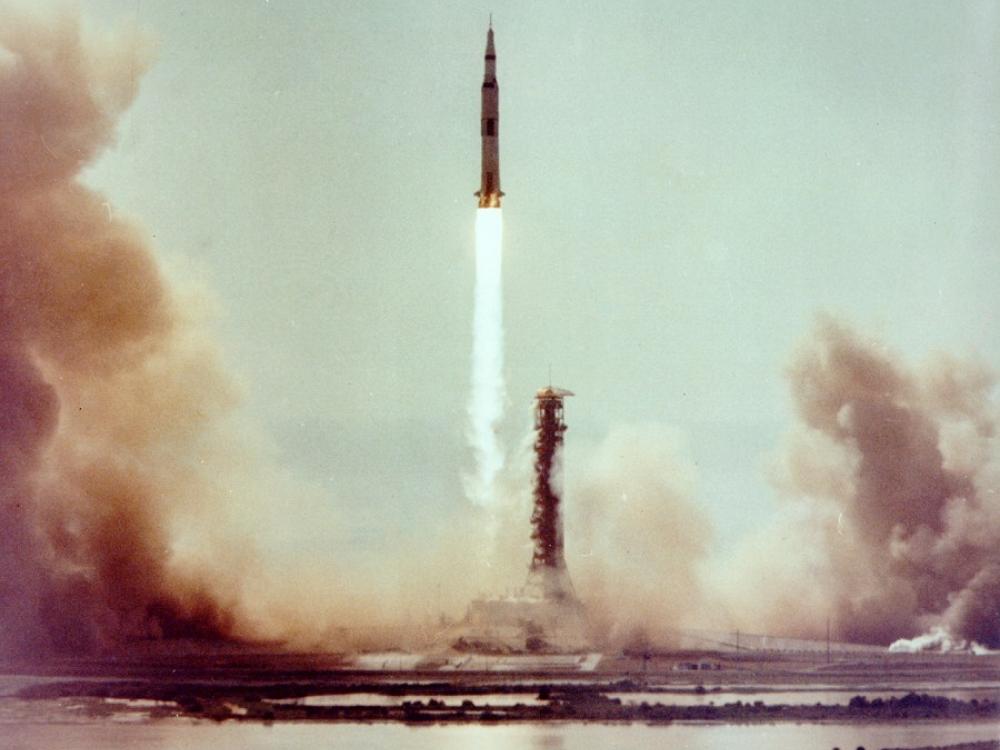Apollo 11
Apollo 11
On July 20, 1969, humans walked on the Moon for the first time.
We look back at the legacy of our first small steps on the Moon and look forward to the next giant leap.
Jump to a Section: Moonshot Mission People Technology On Earth In the Museum Educational Resources
The Moonshot
The Soviet Union launched the first human, Yuri Gagarin, into space on April 12, 1961. Within days of the Soviet achievement, President John F. Kennedy asked Vice President Lyndon Johnson to identify a “space program which promises dramatic results in which we could win.” A little over a month later, on May 25, 1961, Kennedy stood before a joint session of Congress and called for human exploration to the Moon.
The Mission
A Saturn V rocket carrying the three Apollo 11 astronauts blasted off from Cape Kennedy. Over a million spectators, including Vice President Spiro Agnew and former President Lyndon Johnson, came to watch the lift off.
After four days traveling to the Moon, the Lunar Module Eagle, carrying Neil Armstrong and Buzz Aldrin landed on the Moon.
Neil Armstrong exited the spacecraft and became the first human to walk on the moon. As an estimated 650 million people watched, Armstrong proclaimed "That's one small step for man, one giant leap for mankind."
Michael Collins stayed aboard the Command Module Columbia, serving as a communications link and photographing the lunar surface.
Apollo 11 Landing Site
The Sea of Tranquility | Mare Tranquillitatis
00.67408° N latitude, 23.47297° E longitude
For the first lunar landing, the Sea of Tranquility (Mare Tranquilitatis) was the site chosen because it is a relatively smooth and level area. It does, however, have some craters and in the last minutes before landing, Neil Armstrong had to manually pilot the lunar module to avoid a sharp-rimmed ray crater measuring some 180 meters across and 30 meters deep known as West. The lunar module landed safely some 6 km from the originally intended landing site, approximately 400 meters west of West crater and 20km south-southwest of the crater Sabine D in the southwestern part of Mare Tranquilitatis. The lunar surface at the landing site consisted of fragmental debris ranging in size from fine particles to blocks about 0.8 meter wide.
After approximately two and half hours on the Moon, Armstrong and Aldrin returned to the lunar module to begin the journey home.
The three astronauts splashed down in Hawaii on July 24, 1969.
From there they quarantined for three weeks as a precaution against bringing contagion back from the Moon, before the festivities welcoming them home commenced.
Apollo 11 was one of 15 Apollo missions that took place in the late 1960s and early 1970s. Learn more about the missions that paved the way for the Moon landing, and the missions where Americans returned to the Moon after.
The People
Meet the Astronauts
Backup Crew
Three astronauts were selected as backups for the crew: James A. Lovell, commander; William A. Anders, command module pilot; and Fred W. Haise, lunar module pilot. All three backup crew members would eventually fly on Apollo missions. Lovell and Haise were among the crew for Apollo 13.
On the Ground
The Technology
Watching from Earth
On July 20th, across the world, people gathered in front of televisions to watch the moon landing. An estimated 650 million viewers were watching. In the United States, 93% of televisions tuned in to see Neil Armstrong walk on the Moon.
Telling the story of the the Apollo 11 lunar landing includes some of the unique pieces of memorabilia created to mark that human achievement. In addition to the pins, patches, buttons, medals, matchbooks, sweatshirts, and commemorative plates the Smithsonian holds in the national collection, there's this unique ladies handbag.
The day before the launch of Apollo 11, Rev. Ralph Abernathy led a protest to the gates of the Kennedy Space Center. Still reeling from the assassination of Rev. Dr. Martin Luther King Jr., Abernathy led the Poor People’s Campaign of the Southern Christian Leadership Conference (SCLC) to NASA’s doorstep to draw attention to economic and racial inequality. Abernathy chose to stage this phase of the SCLC’s ongoing protest campaign at the site of the lunar launch because it highlighted how much could be done with a dedicated national effort.
In Art
In 1962, just four years after the National Aeronautics and Space Administration was created as a federal agency, James Webb established NASA’s Artist’s Cooperation Program. Webb hoped that the agency’s commission of fine art would help communicate the cultural significance of the space program’s initial advancements.
In the Museum
The gallery shows how an extraordinary combination of motivations, resources, and technologies made it possible for humans to walk on the Moon—and how and why we are going back today.
From big and iconic artifacts like the Command Module Columbia, to fascinating lesser-known artifacts like checklists and Michael Collins’ sunglasses, explore Apollo 11 through our collections.























